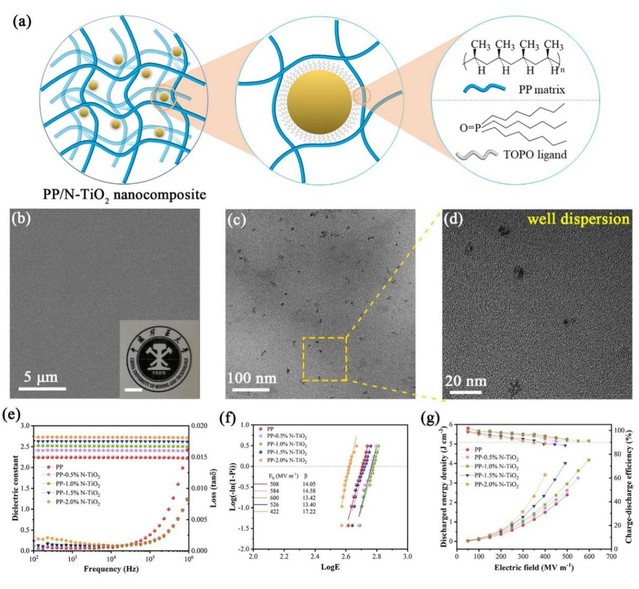CUMT Researchers Made Progress in Dielectric Energy Storage
Publisher : Time : 03.June 2024 Browse the number :

Diagram 1 Non-polar titanium dioxide (TiO2) nanocrystals based
polypropylene composite dielectric and its energy storage capacity
With high breakdown strength, high power density, low dielectric loss, and excellent self-healing properties, polypropylene film capacitors have been widely utilized in pulse power systems. Nonetheless, due to their inherently low dielectric constant of approximately 2.2, the energy storage density of commercially available polypropylene dielectrics is less than 2 J/cm³, making it difficult to develop small-sized film capacitors and hampering their large-scale application. Incorporating inorganic nanoparticles with high dielectric constants into a polypropylene matrix has been proposed to enhance the dielectric constant of polypropylene composite dielectrics. However, this approach is fraught with challenges: poor interfacial compatibility between the matrix and the filler often leads to agglomeration of the nano-fillers. Consequently, while the dielectric constant may increase, there is typically a concurrent decrease in breakdown field strength, thereby limiting the net improvement in energy storage density.
In response to these challenges, Professor Feng Peizhong and Dr. Li Shiheng from the Solid Waste Utilization and High-Performance Ceramics Research Team at the School of Materials and Physics have proposed the use of sub-10-nanometer non-polar titanium oxide (TiO2) nanoparticles as fillers in the fabrication of polypropylene composite dielectrics. Their research systematically investigates the synergistic regulation mechanism of non-polar nanoparticles on the polarization and breakdown behavior of polypropylene dielectrics. Titanium dioxide (TiO2) nanocrystals are synthesized in a non-polar solvent, and during the initial nucleation stage, trioctylphosphine oxide (TOPO) chemically adsorbs onto their surfaces. These molecular ligands play a dual role: on one hand, they enhance the compatibility between the fillers and the polypropylene matrix. On the other hand, they effectively inhibit the aggregation of the filler particles. Furthermore, compared to polypropylene, trioctylphosphine oxide (TOPO) exhibits lower energy levels for both the lowest unoccupied molecular orbital (LUMO) and the highest occupied molecular orbital (HOMO). This unique electronic characteristic enables TOPO to function as an electron trap, capturing charges and thereby enhancing the breakdown field strength of the polypropylene composite material while suppressing dielectric loss. Additionally, the exceptionally high surface area inherent to sub-10-nanometer nanoparticles amplifies interfacial polarization effects, leading to a pronounced rise in the dielectric constant. Consequently, there is a concurrent improvement in both the dielectric constant and the breakdown field strength.The developed composite dielectric exhibits a remarkable discharge energy density of 4.19 J/cm³ under an electric field strength of 600 MV/m, representing a substantial 74.9% increase compared to pure polypropylene film. These groundbreaking findings have been published in the prestigious journal Nano Energy (a top-tier journal in the first zone of CAS, with an Impact Factor of 17.6), under the title “Nonpolar sub-10 nm TiO2 nanocrystal for high energy density polypropylene nanocomposites.” Dr. Li Shiheng from the School of Materials and Physics is credited as the first author. The corresponding authors include Professor Feng Peizhong and Associate Professor Cai Ziming from the School of Materials and Physics, along with Professor Lu Zhenda from Nanjing University.